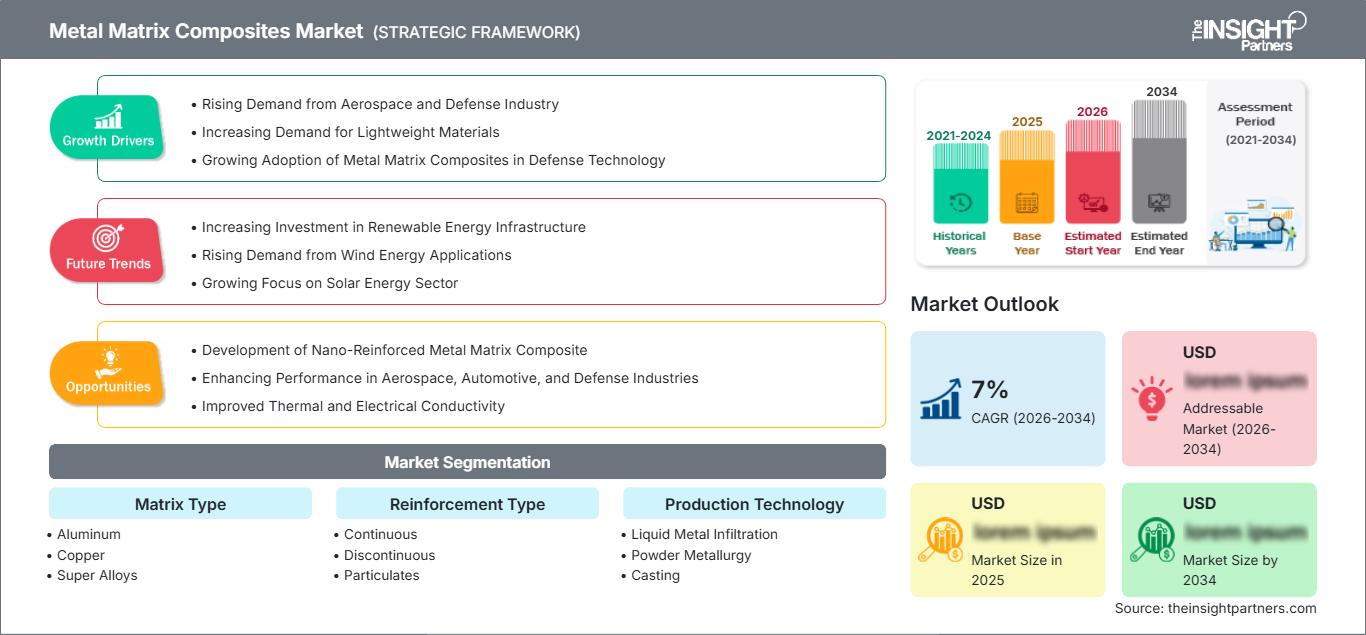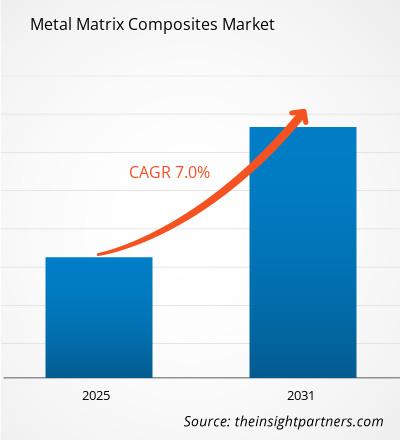Le marché des composites Metal Matrix devrait croître à un taux annuel composé composé de 7 % de 2026 à 2034. Les conditions du marché continuent d’évoluer, ouvrant de nouvelles opportunités pour les parties prenantes. Le paysage global reflète une progression stable et un potentiel de croissance à long terme.
Le rapport présente une analyse basée sur le type de matrice (aluminium, cuivre, superalliages, magnésium, etc.). Le rapport est segmenté par type de renforcement (continu, discontinu, particules, etc.). Le rapport est segmenté par technologie de production (infiltration de métaux liquides, métallurgie des poudres, coulée, et autres). Le rapport est segmenté par matériau d’armature (carbure de silicium, alumine, fibre de carbone, et autres). Le rapport est segmenté par application (automobile, locomotive, électrique et électronique, aérospatiale et défense, marine, médicale, autres). L’analyse mondiale est encore détaillée au niveau régional et des grands pays. La taille du marché et les prévisions aux niveaux mondial, régional et national pour tous les segments clés du marché sont couvertes dans cette portée. Le rapport propose la valeur en USD pour l’analyse et les segments ci-dessus. Le rapport fournit des statistiques clés sur l’état du marché des principaux acteurs et présente les tendances et opportunités du marché.
Objectif du rapport
Le rapport Metal Matrix Composites Market par The Insight Partners vise à décrire le paysage actuel et la croissance future, les principaux facteurs moteurs, les défis et les opportunités. Cela fournira des informations à divers acteurs de l’entreprise, tels que :
- Fournisseurs de technologies/Fabricants : comprendre l’évolution des dynamiques du marché et connaître les opportunités de croissance potentielles, leur permettant de prendre des décisions stratégiques éclairées.
- Investisseurs : Réaliser une analyse complète des tendances concernant le taux de croissance du marché, les projections financières du marché et les opportunités existantes tout au long de la chaîne de valeur.
- Organismes de régulation : Réguler les politiques et contrôler les activités sur le marché dans le but de minimiser les abus, de préserver la confiance et la confiance des investisseurs, et de préserver l’intégrité et la stabilité du marché.
Matrice Métallique Composites Segmentation du marché Type
- de matrice Aluminium
- Cuivre
- Superalliages
- Renforcement magnésium
Technologie de production
continue- de particules
- discontinues
- Infiltration de métaux
- liquides Métallurgie
- Métallurgie Géographie de la coulée
- du Nord
- Europe
- Asie-Pacifique
- Amérique du Sud et Amérique centrale
- Moyen-Orient et Afrique
Vous bénéficierez d’une personnalisation sur n’importe quel rapport - gratuitement - y compris des parties de ce rapport, ou une analyse au niveau du pays, un pack de données Excel, ainsi que de profiter d’offres exceptionnelles et de réductions pour les start-ups et les universités
Marché des composites à matrice métallique: Perspectives stratégiques

-
Obtenez les principales tendances clés du marché de ce rapport.Cet échantillon GRATUIT comprendra une analyse de données, allant des tendances du marché aux estimations et prévisions.
Facteurs de croissance du marché des composites à matrice métallique
- Demande croissante du secteur aérospatial et de la défense : Le secteur aérospatial et de la défense est l’un des principaux moteurs de croissance du marché des composites à matrice métallique. Ces matériaux trouvent de nombreuses applications dans ce domaine, car leur rapport résistance/poids exceptionnel, leur excellente conductivité thermique et leur résistance à la corrosion constituent des propriétés essentielles pour les composants aérospatiaux tels que les moteurs, les cellules d’aéronefs et les engins spatiaux.
- Demande croissante de matériaux légers : La légèreté associée à la résistance est cruciale dans l’industrie aérospatiale pour améliorer le rendement énergétique et les performances. Les composites à matrice métallique sont fabriqués à partir de métaux tels que l’aluminium ou le titane et de renforts céramiques, ce qui leur confère de meilleures propriétés mécaniques et les rend particulièrement adaptés aux composants structuraux. Ce contexte a favorisé l’utilisation des composites à matrice métallique dans les conceptions avancées des secteurs de l’aéronautique aéronautique et spatiale.
- Adoption croissante des composites à matrice métallique dans les technologies de défense : Les applications militaires, notamment les véhicules blindés, les équipements de défense et les systèmes de missiles, constituent d’autres marchés importants pour les composites à matrice métallique (CMM) dans le secteur de la défense. Ces composites offrent une protection et une durabilité élevées sans alourdir les opérations militaires. Par conséquent, les matériaux légers et performants sont très demandés dans le secteur des technologies de défense, ce qui stimule le marché mondial des composites à matrice métallique.
Tendances futures du marché des composites à matrice métallique
- Investissements croissants dans les infrastructures d’énergies renouvelables : Considérée comme une tendance d’avenir, l’infrastructure d’énergies renouvelables devrait créer une demande pour le marché des composites à matrice métallique (CMM). Il est indéniable que le monde s’efforce de promouvoir l’utilisation de sources d’énergie durables. Ainsi, la demande en matériaux avancés à base de composites à matrice métallique augmentera avec le développement des systèmes d’énergies renouvelables tels que les éoliennes et les panneaux solaires.
- Demande croissante pour les applications éoliennes : Par exemple, dans le domaine de l’énergie éolienne, les composites à matrice métallique (CMM) sont principalement utilisés pour les pales de turbines et autres composants structurels, grâce à leurs propriétés telles que la légèreté, la haute résistance et la résistance à la corrosion. La présence de ces matériaux contribue également à améliorer l’efficacité et la durée de vie des turbines, leur permettant ainsi de résister à des conditions environnementales très difficiles. Par conséquent, la demande de CMM pour la fabrication de turbines augmentera avec le développement des projets éoliens.
- Intérêt croissant pour le secteur de l’énergie solaire : Il en va de même pour les applications solaires, où les composites à matrice métallique trouvent de plus en plus d’applications dans les composants des panneaux solaires et les systèmes d’échangeurs de chaleur. Leurs excellentes propriétés de conductivité thermique et de durabilité devraient améliorer les performances des systèmes d’énergie solaire à terme, à mesure que leur fonctionnement se généralise et que leur impact environnemental devient minimal. Par conséquent, face à cette dynamique mondiale en faveur des énergies propres, la demande en matériaux très durables et performants, tels que les composites à matrice métallique (CMM) pour les infrastructures d'énergies renouvelables, devrait s'accroître.
Opportunités du marché des composites à matrice métallique
- Développement de composites à matrice métallique nano-renforcés : Le développement de composites à matrice métallique nano-renforcés (CMM) ouvre de nouvelles perspectives de croissance sur le marché des composites à matrice métallique. Ces composites métallurgiques intègrent des nanoparticules dans la matrice métallique, ce qui améliore significativement les propriétés mécaniques, telles que la résistance, la dureté et la résistance à l'usure. Cette évolution permet d'obtenir de meilleures performances des composites à matrice métallique pour des applications exigeantes dans différents secteurs industriels.
- Amélioration des performances dans les secteurs de l'aérospatiale, de l'automobile et de la défense : Les composites à matrice métallique nano-renforcés sont parfaitement adaptés aux secteurs de l'aérospatiale, de l'automobile et de la défense, où les propriétés massiques des matériaux haute performance sont essentielles. L'utilisation de composants composites à haute résistance permettra une réduction de poids encore plus importante et rendra les composants plus légers qu'auparavant, améliorant ainsi le rendement énergétique et les performances. Ceci favorise incontestablement leur adoption dans les applications critiques.
- Conductivité thermique et électrique améliorée : Les composites à matrice métallique nano-renforcés offrent ainsi une robustesse, une résistance et une durabilité accrues, ainsi qu'une conductivité thermique et électrique améliorée, idéale pour l'électronique, l'énergie et les applications de refroidissement haute performance. Le développement de matériaux avancés stimulera davantage la demande des industries exigeant des propriétés thermiques et électriques spécifiques, amplifiant ainsi le potentiel du marché.
Marché des composites à matrice métallique
Les analystes de The Insight Partners ont analysé en détail les tendances régionales et les facteurs influençant le marché des composites à matrice métallique tout au long de la période de prévision. Cette section aborde également les segments et la répartition géographique du marché de la gestion des troubles du rythme cardiaque en Amérique du Nord, en Europe, en Asie-Pacifique, au Moyen-Orient et en Afrique, ainsi qu'en Amérique du Sud et centrale.
Marché des composites à matrice métallique Report Scope
| Attribut de rapport | Détails |
|---|---|
| Taille du marché en 2025 | US$ XX Million |
| Taille du marché par 2034 | US$ XX Million |
| TCAC mondial (2026 - 2034) | 7% |
| Données historiques | 2021-2024 |
| Période de prévision | 2026-2034 |
| Segments couverts |
By Type de matrice
|
| Régions et pays couverts |
Amérique du Nord
|
| Leaders du marché et profils d'entreprises clés |
|
Acteurs du marché des composites à matrice métallique : comprendre son impact sur la dynamique commerciale
The Marché des composites à matrice métallique is growing rapidly, driven by increasing end-user demand due to factors such as evolving consumer preferences, technological advancements, and greater awareness of the product's benefits. As demand rises, businesses are expanding their offerings, innovating to meet consumer needs, and capitalizing on emerging trends, which further fuels market growth.

- Obtenez le Marché des composites à matrice métallique Aperçu des principaux acteurs clés
Points clés de vente
- Couverture exhaustive : Ce rapport analyse en détail les produits, services, types et utilisateurs finaux du marché des composites à matrice métallique, offrant ainsi une vision globale.
- Analyse d'experts : Ce rapport repose sur une connaissance approfondie du secteur et des analystes.
- Informations actualisées : Grâce à sa couverture des informations et tendances les plus récentes, ce rapport garantit la pertinence des données pour les entreprises.
- Options de personnalisation : Ce rapport peut être personnalisé pour répondre aux besoins spécifiques des clients et s'adapter parfaitement à leurs stratégies commerciales.
Ce rapport d'étude de marché sur les composites à matrice métallique peut donc contribuer à décrypter et comprendre le contexte sectoriel et les perspectives de croissance. Malgré quelques points à améliorer, les avantages globaux de ce rapport l'emportent sur les inconvénients.
- Analyse historique (2 ans), année de base, prévision (7 ans) avec TCAC
- Analyse PEST et SWOT
- Taille du marché Valeur / Volume - Mondial, Régional, Pays
- Industrie et paysage concurrentiel
- Ensemble de données Excel
Rapports récents
Rapports connexes
Témoignages
Raison d'acheter
- Prise de décision éclairée
- Compréhension de la dynamique du marché
- Analyse concurrentielle
- Connaissances clients
- Prévisions de marché
- Atténuation des risques
- Planification stratégique
- Justification des investissements
- Identification des marchés émergents
- Amélioration des stratégies marketing
- Amélioration de l'efficacité opérationnelle
- Alignement sur les tendances réglementaires






















 Obtenez un échantillon gratuit pour - Marché des composites à matrice métallique
Obtenez un échantillon gratuit pour - Marché des composites à matrice métallique